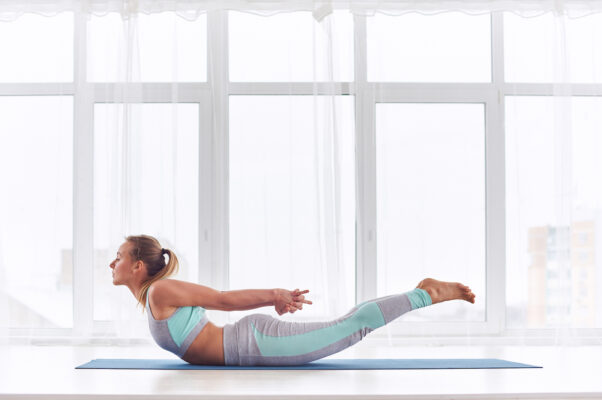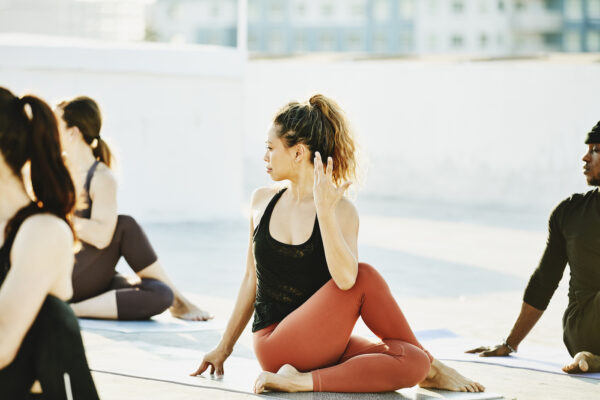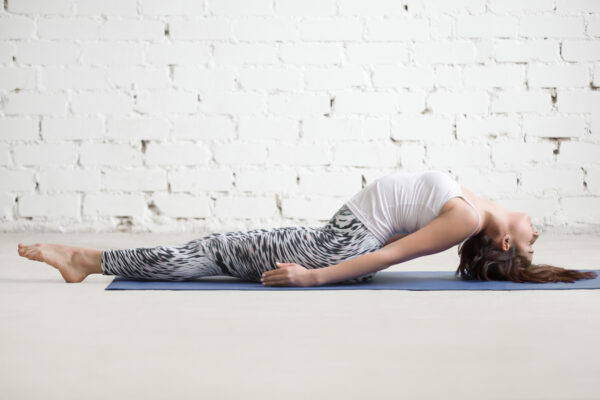8 Stretches To Open Your Heart Chakra During This Stressful Time
- Ambi Kavanagh, Reiki practitioner, astrologer, and author of Chakras & Self-Care
- Emily Schmookler, Emily Schmookler is a senior yoga trainer at CorePower Yoga. She trained and completed her 300-Hour Ayurveda Yoga Teacher Training in July 2018 and her 650-hour Ayurveda Health Counselor training in June 2020, both at Kripalu Center for Yoga.
- Jeffrey Posner, Jeffrey Posner is a New York- and New Jersey-based yoga teacher and the creator of Yoga Framework.
- Kino MacGregor, international yoga teacher, and inspirational speaker
- Parita Shah, Reiki practitioner and energy healer
What are chakras, and how do they play into emotional and physical feelings?
Chakras are centrally-aligned points throughout the body through which our energy flows. Anatomically, they run from the crown chakra at the top of the head, passing through the third-eye chakra in the forehead, down the length of the spine, through the throat, heart, solar plexus, and sacral chakras, and ending in the root chakra at your feet.
You can picture the chakras as spinning wheels, Ayurvedic expert and Reiki practitioner Parita Shah previously told Well+Good: "If a chakra is spinning too fast, that would be considered overactive. If it's spinning too slowly, it's under-active. And the flow of that energy is determined by our thoughts, feelings, memories, and experiences."

{{post.sponsorText}}
In either case, the imbalance may be referred to as a blocked chakra, says Emily Schmookler, senior yoga trainer at CorePower Yoga. Physically, she says, a blockage can make the area feel tight or cramped, or even lead to a related physical ailment in the region. And emotionally, an imbalance can lead us to feel either closed-off, or overly expressive in negative ways. "When our chakras are balanced, we feel more at ease, communication is clear, and boundaries feel unrestricted," she says.
To put it more simply? “Think about the chakras as intersections where a massive amount of traffic crosses,” suggests Kino MacGregor, founder of Omstars. “When there’s a traffic jam, it can feel like a stuck emotion or a behavioral or physical rut.”
What's special about the heart chakra?
While every chakra plays a role in physical wellbeing, perhaps the most important emotional energy center is the heart chakra, which is found at the center of the chest and between the shoulder blades in the back.
"The heart chakra is considered the energetic bridge between the physical and spiritual realms," says Ambi Kavanagh, Reiki practitioner and author of Chakras & Self-Care. "The Sanskrit name for it is Anahata, which means 'unstruck, unhurt, unbeaten.'"
In general, the heart chakra is at the root of how we love, serve, give, and receive, says Schmookler. And it plays a vital role in processing our energy and lifting our thoughts and behaviors towards compassion, empathy, and kindness, adds MacGregor. To that end, a balanced heart chakra is an essential component of positive human connection, making its function of particular note during times of collective trauma, such as now.
Not to mention, it sits at the midline of the other six chakras in the body, and holds sway over the balance and enlightenment of the system as a whole, making it especially important to unblock (or keep unblocked) during any stressful time.
How might the heart chakra become blocked?
As with all the chakras, an imbalance in the heart chakra can stem from either under- or over-activity, says Kavanagh. "If it's underactive, the energy flow is stagnant, and as a result, we may feel emotionally numb," she says, citing a lack of love and affection in childhood, the experience of heartbreak, or any other unprocessed emotional trauma as potential causes. "If it's overactive, you may have a surplus of energy flowing, pushing you toward an over-dependence on others," she says. "Often, with an overactive heart chakra, a person cannot receive love because they don't yet love themselves, which can lead to people-pleasing, insufficient boundaries, and co-dependency."
As such, the first step in opening a blocked heart chakra is to confront past emotional traumas and to feel all the feelings that bubble to the surface as a result. But, of course, that's far easier said than done. Journaling and meditation can be helpful starting points, as are spending time with animals or young children and volunteering, says Kavanagh, citing these practices as a way of reconnecting to emotions of empathy.
You can also begin the practice of accessing and re-balancing the heart chakra through physical means, however, by diffusing essential oils in your home (Kavanagh suggests rose, jasmine, neroli, and lavender) and practicing stretches that direct your mental and physical attention to this energy center. Below, yoga teachers and Ayurvedic experts share the yoga poses that can help you do just that.
Here are 8 stretches to open up your heart chakra:
1. Eagle Arms

“Wrap your right elbow under your left, flip your palms in, and hook your hands together, dropping your shoulders for easeful access,” Schmookler instructs, noting that this opens the back of the heart-chakra space. After holding the pose for a few seconds, switch your arms, wrapping your left elbow under right. “This position can be expressed with the lower half of the body in any pose,” Schmookler adds. And for more shoulder release, you can also lift your elbows up in line with shoulders.
2. Locust Pose

sandsun
“Lying stomach-down on your mat, ground your legs and hips, and lift the trunk, taking the spine into extension,” instructs Jeffrey Posner, a New York- and New Jersey-based yoga teacher and the creator of Yoga Framework. “Avoid using the hands or arms as leverage against the floor. Then slowly lift the legs as a tool to enhance the extension in the spine.” This is also frequently referred to as Superman pose.
3. Camel Pose

“Start off in a kneeling position,” MacGregor says, noting to align the knees and feet with each other and to keep both of them hip-width apart. “Inhale as you lift your ribs away from your hips and create space between each joint of the spine. Send the pelvis slightly forward as you engage your back muscles, then exhale and bring your hands back behind you, placing the palms on the soles of the feet, fingers pointed towards the toes. Internally rotate the shoulders and drop the head gently back.”
Once you're in the position, stay for five deep breaths before slowly shifting back to the starting position, releasing one vertebra at a time. “By thrusting the heart chakra forward, this pose can help physically open and expand this energy center,” says Kavanagh.
4. Half or Full Bind

You can practice binds while sitting with one leg bent or standing in a side angle. Whichever you choose, Schmookler says to sweep your top arm (that is, the arm opposite from the bent leg) behind you, reaching for the top of your bent thigh, in order to create a half-bind. For a full bind, she says to reach your other arm (the one aligned with your bent leg) underneath that thigh, connecting it with your other hand. “Once in the lock, pull your hands apart and rotate your chest upward for a deep heart opening,” she instructs.
5. Cobra Pose

“Start off lying on your stomach,” MacGregor instructs, noting to point the toes and align the legs hip-width apart. “Engage the thighs and soften the glutes. Inhale as you lift the rib cage away from the hips and come up onto your elbows. Place the elbows on the ground slightly in front of the shoulders, and elongate the neck.” From there, she says to focus on sending your sternum up and forward, extending your arms if you wish. Whether you stay on your elbows or push up to your hands, breathe in your final pose for five full breaths before lowering back down.
6. Chest expansion

“Interlace all of your fingers behind your back, and press your grip towards the floor to bolster your heart space up,” Schmookler says. Or, alternatively, explore the same expansion while in a forward fold, by simply maintaining your grip and bending forward at the waist.
7. Fish or Supported Fish

“To perform a supported fish, lie down on your back and place a yoga block, bolster, or book under your shoulders to shift your chest upward,” Schmookler says. For a full fish, start from a seated position and extend your legs forward in front of you. “Walk your palms behind your glutes, point your fingers towards your glutes, and lower onto your forearms,” she instructs. “Kiss your shoulder blades together and allow your head to tilt up and back.” If your head feels unstable, you can also prop it on a block.
8. Puppy pose

“Start off on your hands and knees in a Tabletop Pose,” MacGregor says, noting that your hands and legs should be shoulder- and hip-width apart. “Slowly walk the hands forward until your chest reaches towards the ground. Lift the ribs away from the hips, and place either the forehead or the sternum on the ground, depending on which is more accessible and comfortable for you,” she says. Close your eyes and stay in the pose for five deep breaths.
While practicing any of the above, it's essential to also remember that to strengthen the heart chakra requires a deep intimacy with whatever wounds you carry, says MacGregor. “It is not possible to truly energize the heart if we are unwilling to be vulnerable.” As such, you could very well feel a sudden emotional release while holding any of these poses, adds Kavanagh. “Don't be surprised if tears start to flow during or shortly after,” she says. “That simply reflects a release of a blockage and indicates that healing is taking place.”
For more ways to keep your heart chakra open, follow along with this flow:
Oh hi! You look like someone who loves free workouts, discounts for cutting-edge wellness brands, and exclusive Well+Good content. Sign up for Well+, our online community of wellness insiders, and unlock your rewards instantly.
Loading More Posts...